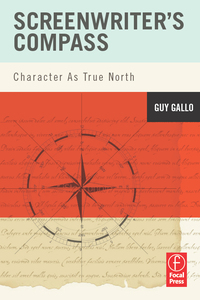
Movies

Book Review: Guy Gallo's 'Screenwriter's Compass: Character as True North'
The tough thing about many screenwriting books (an Amazon search lists a whopping 2342 of 'em) is that authors always seem to be trying to talk their readers out of actually writing a screenplay. Look to your left... look to your right... one of those people will not be here at the end of the... Zzzzzz. WE GET IT! It is like your teacher calling you a lazy student on the first day of school. Obviously, writing a good screenplay can be an almost insurmountable task but, to feel patronized by the book you just spend a cool twenty bucks on – kind of hurts.
Refreshingly, that is not at all the case with Guy Gallo's Screenwriter's Compass: Character as True North, a top notch new release from Focal Press. How's that for a twist?
As a philosophy, author Gallo wisely emphasizes the importance of character above plot and situation. For countless aspiring screenwriters, the bible is a book called Save the Cat by Blake Snyder, which on the surface would seem to emphasize the exact opposite.
To briefly explain: the term 'save the cat' refers to the idea that the writer should have their protagonist metaphorically (or literally, if the writer has no imagination) save a helpless cat early in the script. The presumption is that any person who rescues a cute, defenseless animal from peril immediately becomes a likeable character, one whom the audience will happily follow and root for until the film's end. Gallo thinks differently. You might be on board with the Cat-Saver character, but only because of the situation and circumstances. Movie fans tend to forget that a screenwriter can have an alien spacecraft or a dancing walrus show up at the drop of a hat.
Um... what do I mean by that?
As a writer, it is so easy to artificially manipulate the story and situation your characters inhabit that it can become a hackneyed and tedious writing crutch. Writers block can easily be cured by simply typing the words: "... and then, a robot walks in." But having a robot randomly putter into the room during your climatic Christmas party scene might not play as realistically as you hope. Think of a few of your favorite movies. I'll bet money that the reason you re-watch those films is because you enjoy revisiting those characters. (To use a few of my favorites as examples: Rushmore, Goodfellas, Boogie Nights, The Big Lebowski, etc. See what I mean about character?)
The book is filled with unique, practical, and constructive advice, but at times it can be a very dense read. Upon completing the book, I felt almost woozy. It was like taking a Master Class in Screenwriting in 3 days. I then re-read the book -- this time making a few notes -- and found it to be more easily digestible.
Often Gallo gives us two examples of whatever he is discussing: The version that sucks and the version that actually works. As simplistic as it may sound, this technique is very effective in allowing even struggling beginners to understand some fairly advanced writing concepts. But I'll admit that it took a few pages to acclimatize to Gallo's vernacular.
The author has a way of writing that occasionally borders on being imposing or overly formal. I became turned off until I realized something around page eleven. Gosh darn it -- he does make a lot of really good points. In stressing the importance of character over situation, Gallo hits on a key facet of screewnwriting, one that is often overlooked: Better that your script be about someone, rather than something. Something Movies usually set up a premise in the first couple pages and then spend the remainder of the script merely trying to live up to that initial premise. A quick online search confirms that Gallo truly heeds his own advice.
In 1984, Guy Gallo worked (as screenwriter) alongside one of the greatest storytellers of all time, John Huston, on a film adaptation of Malcolm Lowry's novel, Under the Volcano. (I was going to recommend you see Under the Volcano, but I'll amend that Wholesale Fashion Jewelry and say you should see that and every other movie directed by Huston as well.) The film follows a disgraced alcoholic British consul living in Mexico, played masterfully by Albert Finney. The source material is infinitely rich with detail, but Gallo instead concentrated on the character of the British consul himself, who proves to be stunningly well-drawn. Someone, not something.
Presently, Gallo teaches screenwriting at Columbia University of the Fine Arts and in the past, taught Modern Drama at both Princeton and NYU. He also maintains an excellent blog, available here. Screenwriter's Compass: Character as True North is an endlessly beneficial resource for up and coming screenwriters. Make no mistake: Gallo knows exactly what he is writing about. So, before you complete that next draft, you might want to give this one a read.
Tags: book review, screenwriting, Screenwriter's, Compass, Guy Gallo, Under the Volcano, John Huston, Blake Snyder, Malcolm Lowry, Screenwriter's Compass Character as True North
Related Posts
- Punch Up Your Life - Logan Come Home (Logan Stefanson)
- Punch Up Your Life - Jazz Hands of Justice (Jessica Buchanan)
- Punch Up Your Life - Friend at the End (Jessica Seburn)
- Punch Up Your Life - This is Not That (J.D. Renaud)
- Punch Up Your Life - A Heart Walk (Ava Julien)
Tony Hinds is a Canadian writer who studied film at the University of Winnipeg. In addition to ShowbizMonkeys.com, Tony has reviewed films for Step On Magazine and The Uniter. You can find Tony on Twitter.






Comments Posted (